39 elements and compounds in food labels
Food Labels | CDC - Centers for Disease Control and Prevention If you eat the whole thing, you are eating 8 times the amount of calories, carbs, fat, etc., shown on the label. Total Carbohydrate shows you types of carbs in the food, including sugar and fiber. Choose foods with more fiber, vitamins, and minerals. Choose foods with lower calories, saturated fat, sodium, and added sugars. Avoid trans fat. Food Additives and Compounds | Nutrition.gov Consumer Info About Additives & Ingredients. HHS, Food and Drug Administration, Center for Food Safety and Applied Nutrition. Find information from the Food and Drug Administration ( FDA) on benzene, color additives, fat substitutes, food irradiation, preservatives, sweeteners, sulfites, and more.
Food Labels | Nutrition.gov Folate and Folic Acid on the Nutrition and Supplement Facts Labels HHS, Food and Drug Administration, Center for Food Safety and Applied Nutrition Learn what common foods are natural sources of the vitamin folate, plus what foods may have folic acid added during processing. Interactive Nutrition Facts Label HHS, Food and Drug Administration

Elements and compounds in food labels
Q6. How did you classify the substances from the food label above as ... 5 people found it helpful mancymalhotra Answer: It's elements if the minerals found in the food label are (Iron,Calcium, Magnesium, Selenium) it is compound if two or more elements are mixed together such as Sodium (Na) and Chlorine (Cl) if they are combined together it will become sodium chloride which is also known of its name (SALT) look and bring any food product label paste your chosen food product ... A chemical compound is a chemical substance composed of numerous indistinguishable particles composed of molecules from more than one element held together by chemical bonds. A particle comprising of iotas of only one element is in this way, not a compound. Glucose - C6H12O. Sucrose (standard sugar) - C12H22O. Lactose - C12H22O. Elements and Compounds On Food Labels: Performance Task No.2 (Quarter 1 ... c. recognize that some elements are essential for human body. Materials: food label, glue or tape, scissors, bond paper Procedure: 1. Choose one food label. 2. Cut and paste the nutrition facts in your bond paper. 3. Below the nutrition facts, make a table and list down at least three compounds and their constituent elements.
Elements and compounds in food labels. Table 1. Compounds and their constituent elements written in the food ... ★★ Tamang sagot sa tanong: 2. List down in Table 1 the compounds in the product label and its constituent elements. not be obvious from the compound name (e. g., citric acid, oil).Table 1. Compounds and their constituent elements written in the food labels - studystoph.com Food labels - Better Health Channel - Victoria Use-by and best-before dates on food labels. Foods with a shelf life of less than 2 years must have a best-before or use-by date. These terms mean different things. Best-before date on food labels. The best-before date refers to food quality - food stored in the recommended way will remain of good quality until that date. Activity 2. Let s Hunt Elements and Compounds! Directions: Identify ... Let's Hunt Elements and Compounds! Directions: Identify compounds and their corresponding constituent elements found in the food labels. Nutrition Facts Serving Size 4 Cookies (30g) Servings Per Container About 11 Amount Per Serving Calories 120 Total Fat og Saturated Fat 30 Trans Fotog Cholesterol 20mg Calories from Fat Sodium 90mg Total ... Table.1 Compounds and their constituent elements written in the food ... Table.1 Compounds and their constituent elements written in the food labels. - 4050407. answered Table.1 Compounds and their constituent elements written in the food labels. 1 See answer ... Maghanap ka ng 2 Compound na makikita sa nutrition fact, tapos pag naka pili kana isulat mo constituent elements nila .
Understanding Food Labels - Nutrition: Science and Everyday Application ... The value printed on the Nutrition Facts panel is the percent DV, which tells you how much one serving of the food contributes towards meeting the daily requirement for that nutrient. The FDA uses the following definitions for interpreting the %DV on food labels:4. 5%DV or less means the food is low in a nutrient. Food energy - Wikipedia Food energy is chemical energy that animals (including humans) derive from their food to sustain their metabolism, including their muscular activity.. Most animals derive most of their energy from aerobic respiration, namely combining the carbohydrates, fats, and proteins with oxygen from air or dissolved in water. Other smaller components of the diet, such as organic … 5 Basic Elements that MUST be on Your Food Label Here are the five elements that must go on every food label according to the FDA: #1: Statement of Identity. Your product must be clearly identified on the package label. For example, a sauce jar label could have something like "Ethiopian Sauce. Made with 35 herbs and spices!" You must also indicate the intended use. Definition of Compounds & Elements - Examples, Types & Classification ... Compounds can be defined as substances consisting of 2 or more different types of elements in a fixed ratio of their atoms. When the elements combine, some individual property of the elements is lost and the newly formed compound has new properties. Chemical Formula: Compounds are represented by their chemical formula.
Activity 2. Let's Hunt Elements and Compounds! - Brainly.ph Compounds Sugar - made up of oxygen, carbon, hydrogen Butter - made up of calcium, sodium, potassium Salt - made up of sodium, chlorine (some types may even have iodine) Soy - sodium, potassium, phosphorus, calcium Sodium Bicarbonate or Baking Soda - hydrogen, carbon, oxygen Wheat - iron, manganese, calcium, phosphorus, selenium, sodium, potassium Food Product Labeling Basics | Oklahoma State University Required Elements of a Food Label The Federal Food, Drug and Cosmetic Act (FD&C) requires five elements to appear on a food label: Name of the food Net quantity of contents Name and address of the manufacturer Statement of ingredients Nutrition information Elements of a Food Label - Jet-Label Product Category Mention the type of product it is - whether it's cookies, sauce, spices, chocolate, dairy products or any other food type. Also include details such as vegetarian or non-vegetarian, organic or free range, etc. Any certifications from authorized organizations should also be mentioned on the label. Qtr 1 module 4 elements & compounds - SlideShare infer the food ingredient that could be the source of those listed elements; and 4. recognize that most of these food ingredients are examples of compounds. Materials Needed food labels Procedure 1. Refer to the labels of different food products below.
Di Activity 2. Let s Hunt Elements and Compounds!Directions: Refer to ... List down in Table 1 the compounds in the product label and the constituent elements. There are cases that you will need to look at the constituent elements because they may not be obvious from the compound name (e.g., citric acid, oil). Table 1. Compounds and their constituent elements written in the food labels. Compound Constituent Element
Elements within the Nutrition Facts table - Canadian Food Inspection Agency A 60 g serving of food contains 4.26 mg of niacin and 7.5 g of protein from a mixed source: NE in mg from niacin alone = 4.26 mg. Calculate the amount of tryptophan (which is 1.1% of the protein) 1.1% x 7.5 g protein = 0.082 g tryptophan = 82 mg. Using the conversion formula above, divide mg of tryptophan by 60.
Ii content elements and compounds on food labels iii Ii content elements and compounds on food labels iii SchoolSorsogon State College Course TitleEDUCATION MISC Uploaded Byjoanespenida Pages580 This previewshows page 167 - 171out of 580pages. Students who viewed this also studied Marikina Science High School SCIENCE 7 1 40.jpg Nutrition Maize cocoa powder 1 page 40.jpg
Elements and Compounds in food label & other products ( Module3-Q1 ... elements and compounds in food label and other productplease don't forget to subscribe if you haven't and click the bell button if you want to be notified on...
Elements, Compounds, and a Vocabulary Card Sort Figure 2: Sorting particle diagram cards into Pure Substance and Mixtures. I gave my students baggies of cards that had category titles and particle diagrams (figure 1). I instructed them to first find the labels for Pure Substances and Mixtures and put the category titles Elements and Compounds aside. Then, they took all the particle diagram ...
Elements, Compounds & Mixtures in Food Science by Donna Blalock - Prezi Food Science element symbols- H, C, N, O , S, P, Na, Al. Formulas - represents compounds. Caffeine - C8 H10N4O2. Sodium bicarbonate - NaHCO3. Sodium Chloride- ? Elements - simplest form of matter that can exist under normal lab conditions. (110+ elements) Elements most used in food science -. carbon, hydrogen, oxygen, sulfur, and nitrogen.
ELEMENTS AND COMPOUNDS IN FOOD LABELS AND THEIR USES - YouTube Please like, share and subscribe! Thank you!
Science: Quarter 1 - Module 3: Elements and Compounds • Identify elements and compounds from the food labels and other products available at home, market and the community. After going through this module, you are expected to: 1. Name elements and compound that are present from the food labels of the product 2. Emphasize that elements are listed in the Nutrition Facts of the food 3.
Elements Found in Food - The effect of the elements ... There are 6 elements found in almost all foods. These elements are carbon, hydrogen, nitrogen, phosphorus, and sulfur. There are also 5 elements found as salts (dissolved). They are sodium, magnesium, chlorine, potassium, and calcium. There are 3 trace elements, which means they are found in very small amounts in organisms.
Key Elements of a Food Label To Know | Food Labeling Info Below is a diagram of the key elements that should be on your food label: Ways to Enhance Your Labels When creating food labels, you should first research and examine the product's nutritional contents. Be aware that your claims can become empty statements to consumers if they think that the label's information is misleading.
Food Labels (for Teens) - Nemours KidsHealth Some important vitamins and minerals are included on the Nutrition Facts label: Vitamin D is needed to absorb calcium to build bones and keep them strong. It also plays a part in heart health and fighting infection. Calcium is needed for strong bones. It keeps nerves and muscles working and the heart healthy.
Elements and Compounds On Food Labels: Performance Task No.2 (Quarter 1 ... c. recognize that some elements are essential for human body. Materials: food label, glue or tape, scissors, bond paper Procedure: 1. Choose one food label. 2. Cut and paste the nutrition facts in your bond paper. 3. Below the nutrition facts, make a table and list down at least three compounds and their constituent elements.
look and bring any food product label paste your chosen food product ... A chemical compound is a chemical substance composed of numerous indistinguishable particles composed of molecules from more than one element held together by chemical bonds. A particle comprising of iotas of only one element is in this way, not a compound. Glucose - C6H12O. Sucrose (standard sugar) - C12H22O. Lactose - C12H22O.
Q6. How did you classify the substances from the food label above as ... 5 people found it helpful mancymalhotra Answer: It's elements if the minerals found in the food label are (Iron,Calcium, Magnesium, Selenium) it is compound if two or more elements are mixed together such as Sodium (Na) and Chlorine (Cl) if they are combined together it will become sodium chloride which is also known of its name (SALT)




![Best Answer] List down in Table 1 the compounds in the ...](https://ph-static.z-dn.net/files/da0/ef4a99e2f1b9e01d99a3c2e925b2b8c5.jpg)


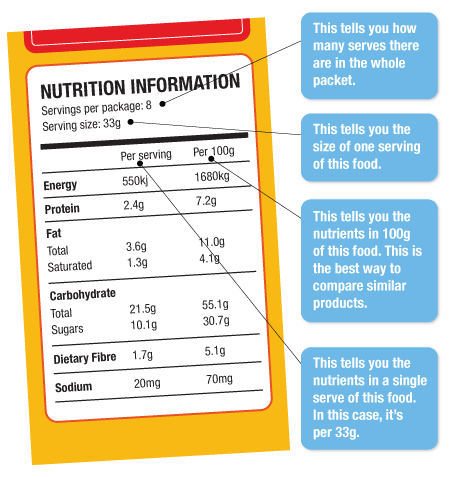


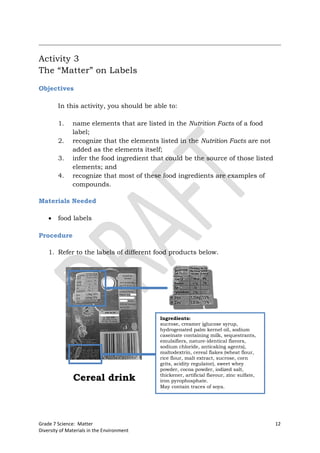
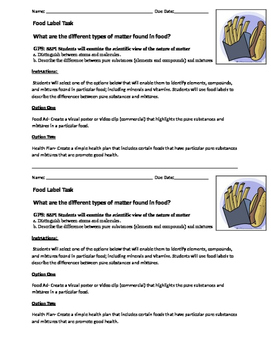

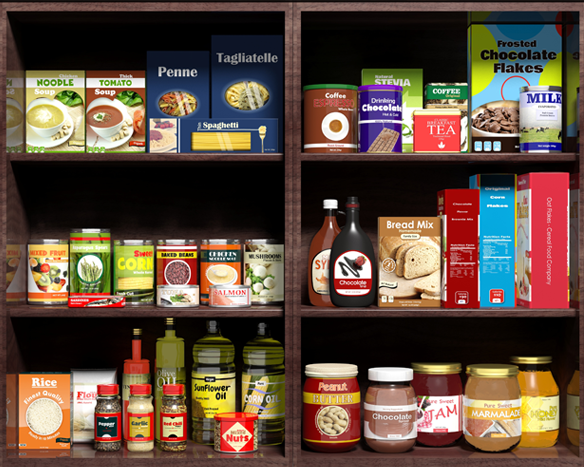
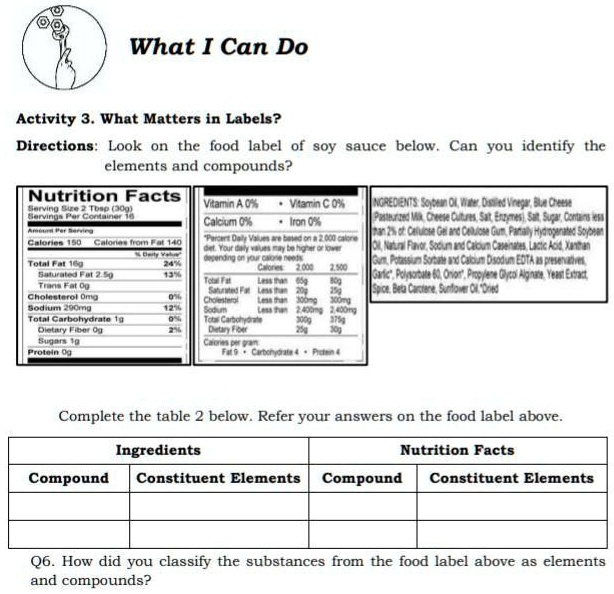


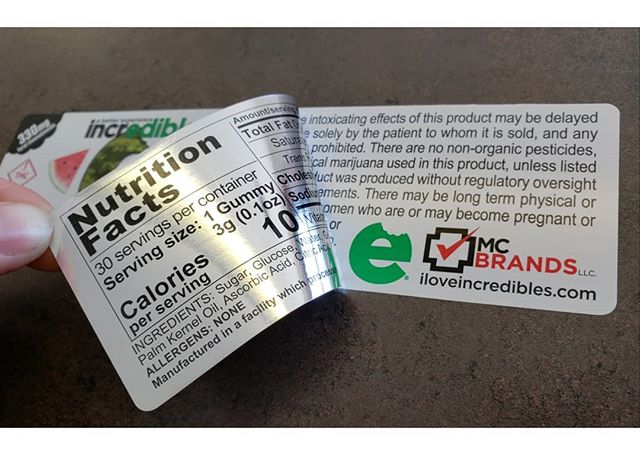



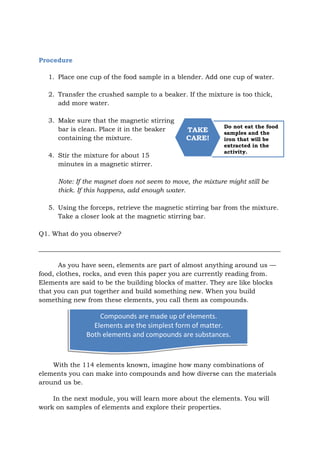


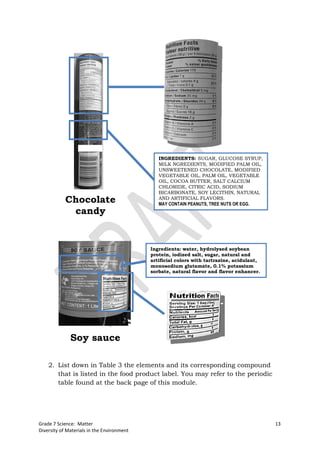

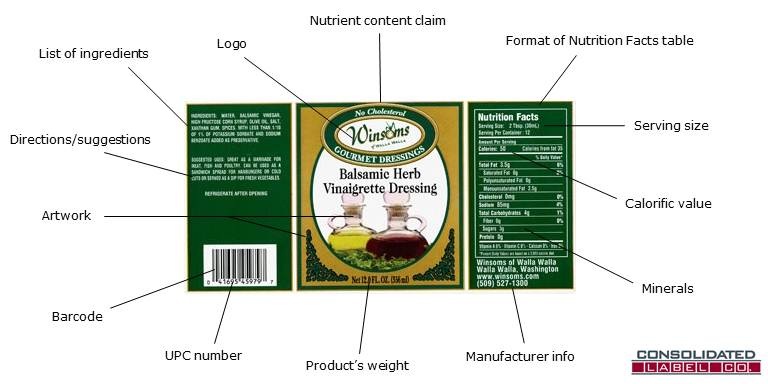



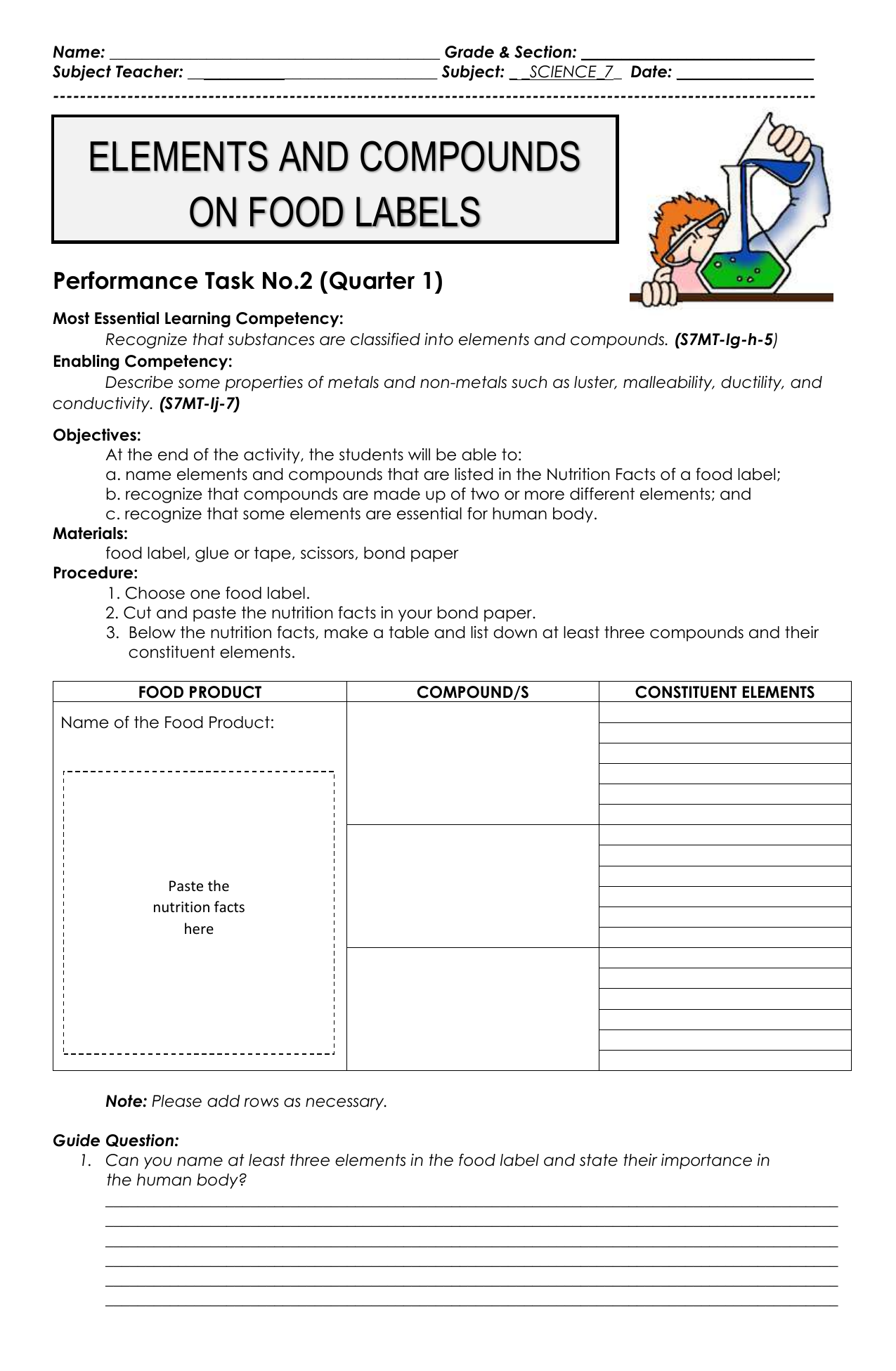



Post a Comment for "39 elements and compounds in food labels"